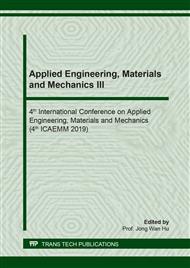[1]
V. Duraipandiyan, S. Ignacimuthu, M. G. Paulraj, Antifeedant and larvicidal activities of Rhein isolated from the flowers of Cassia Fistula L, Saudi J. Biol. Sci. 18(2) (2011) 129-133.
DOI: 10.1016/j.sjbs.2010.12.009
Google Scholar
[2]
H. Mirhosseini, B. T. Amid, a review study on chemical composition and molecular structure of newly plant gum exudates and seed gums, Food Res. Int. 46(1) (2012) 387-398.
DOI: 10.1016/j.foodres.2011.11.017
Google Scholar
[3]
K. Huanbutta, W. Sittikijyothin, Development and characterization of seed gums from Tamarindus indica and Cassia fistula as disintegrating agent for fast disintegrating Thai cordial tablet, Asian J. Pharm. Sci. 12(4) (2017) 370-377.
DOI: 10.1016/j.ajps.2017.02.004
Google Scholar
[4]
W. Sittikijyothin, D. Torres, M. P. Gonçalves, Modelling the rheological behaviour of galactomannan aqueous solutions, Carbohydr. Polym. 59(3) (2005) 339-350.
DOI: 10.1016/j.carbpol.2004.10.005
Google Scholar
[5]
K. Khounvilay, W. Sittikijyothin, Rheological behaviour of tamarind seed gum in aqueous solutions, Food Hydrocoll. 26(2) (2012) 334-338.
DOI: 10.1016/j.foodhyd.2011.03.019
Google Scholar
[6]
M. M. Cross, Rheology of non-Newtonian fluids: a new flow equation for pseudoplastic systems, J. Colloid Sci. 20(5) (1965) 417-437.
DOI: 10.1016/0095-8522(65)90022-x
Google Scholar
[7]
A. I. Bourbon, A. C. Pinheiro, C. Ribeiro, C. Miranda, J. M. Maia, J. A. Teixeira, A. A. Vicente, Characterization of galactomannans extracted from seeds of Gleditsia triacanthos and Sophora japonica through shear and extensional rheology: Comparison with guar gum and locust bean gum, Food Hydrocoll. 24(2 3) (2010) 184-192.
DOI: 10.1016/j.foodhyd.2009.09.004
Google Scholar
[8]
L. Xu, G. Xu, T. Liu, Y. Chen, H. Gong, The comparison of rheological properties of aqueous welan gum and xanthan gum solutions, Carbohydr. Polym. 92(1) (2013) 516-522.
DOI: 10.1016/j.carbpol.2012.09.082
Google Scholar
[9]
N. Gorret, C. Renard, M. H. Famelart, J. L. Maubois, J. L. Doublier, Rheological characterization of the EPS produced by P. acidi-propionici on milk microfiltrate, Carbohydr. Polym. 51(2) (2003) 149-158.
DOI: 10.1016/s0144-8617(02)00141-8
Google Scholar
[10]
F. M. León-Martínez, J. Rodríguez-Ramírez, L. L. Medina-Torres, L. L. Méndez Lagunas, M. J. Bernad-Bernad, Effects of drying conditions on the rheological properties of reconstituted mucilage solutions (Opuntia ficus-indica), Carbohydr. Polym. 84(1) (2011) 439-445.
DOI: 10.1016/j.carbpol.2010.12.004
Google Scholar
[11]
P. B. Albuquerque, Jr. W. Barros, G. R. Santos, M. T. Correia, P. A. Mourão, J. A. Teixeira, M. G. Carneiro-da-Cunha, Characterization and rheological study of the galactomannan extracted from seeds of Cassia grandis, Carbohydr. Polym. 104 (2014) 127-134.
DOI: 10.1016/j.carbpol.2014.01.010
Google Scholar
[12]
N. A. Thombre, P. S. Gide, Rheological characterization of galactomannans extracted from seeds of Caesalpinia pulcherrima, Carbohydr. Polym. 94(1) (2013) 547-554.
DOI: 10.1016/j.carbpol.2013.01.051
Google Scholar


